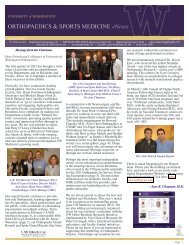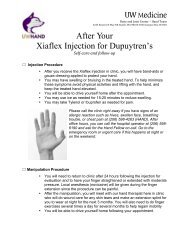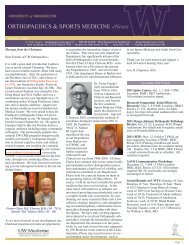2002 - University of Washington Bone and Joint Sources
2002 - University of Washington Bone and Joint Sources
2002 - University of Washington Bone and Joint Sources
Create successful ePaper yourself
Turn your PDF publications into a flip-book with our unique Google optimized e-Paper software.
(A)<br />
(B)<br />
(C)<br />
(D)<br />
Figure 1: Patient with an O3A fracture. A) Lateral radiograph <strong>of</strong> injury; B) Open wound; C) Lateral radiograph <strong>of</strong> initial reduction; D) Lateral radiograph<br />
<strong>of</strong> reduction at 5 years.<br />
ORIF, his incisions appeared to be in<br />
excellent condition. On follow up here<br />
at six weeks <strong>and</strong> four months after<br />
surgery, his right foot was, however, not<br />
completely healed in the apex <strong>of</strong> the<br />
surgical incision. He was treated with<br />
antibiotics for Staphylococcus sp. <strong>and</strong><br />
experienced drainage <strong>and</strong> intermittent<br />
cellulitic symptoms until his hardware<br />
was removed nine months after surgery.<br />
This incision healed uneventfully.<br />
The next patient experienced<br />
persistent drainage from his incision<br />
that required IV antibiotics on two<br />
occasions; wound cultures grew<br />
Staphylococcus epidermidis. This<br />
patient had significant compliance<br />
problems <strong>and</strong> refused to consistently<br />
take his oral antibiotics or to quit<br />
smoking <strong>and</strong> was lost to follow up for<br />
several months. He also had hepatitis<br />
C for which he refused treatment. He<br />
reappeared at one year after his initial<br />
surgery <strong>and</strong> was noted to be cellulitic<br />
over the lateral aspect <strong>of</strong> the incision<br />
with a draining wound. His hardware<br />
was removed <strong>and</strong> he healed without<br />
further intervention.<br />
Another patient presented for initial<br />
treatment with a full thickness eschar<br />
on his heel <strong>of</strong> uncertain etiology <strong>and</strong><br />
required ORIF for a second metatarsal<br />
fracture in addition to the calcaneal<br />
fracture. His surgical incisions initially<br />
appeared to heal well, but ultimately<br />
became infected with Staphylococcus<br />
aureus. He developed a deep infection<br />
<strong>and</strong> required two episodes <strong>of</strong> I&D with<br />
IV antibiotics. His hardware was<br />
removed at ten months from the initial<br />
surgery <strong>and</strong> his foot healed without<br />
further complications. He eventually<br />
required a subtalar fusion to resolve<br />
chronic pain from subtalar arthritis,<br />
which developed due to the devastating<br />
nature <strong>of</strong> the initial injury, <strong>and</strong> healed<br />
uneventfully from this surgery.<br />
In an interesting case, a nonsmoking,<br />
compliant patient with<br />
bilateral, medially open fractures (O2,<br />
O3A) healed by primary intention, but<br />
began to spontaneously drain 10<br />
months after surgery from the lateral<br />
aspect <strong>of</strong> his left heel (O2), ultimately<br />
developing a deep infection. The<br />
hardware in his left foot was removed<br />
one year post surgery; cultures showed<br />
coagulase negative Staphylococcus<br />
epidermidis <strong>and</strong> Enterobacter cloacae.<br />
This incision healed uneventfully. The<br />
right foot (O3A) never developed<br />
wound healing problems.<br />
The final patient, a compliant nondiabetic<br />
smoker, had a medially open<br />
right calcaneus fracture (O3A) as well<br />
as closed left tibia-fibula <strong>and</strong> pelvic<br />
fractures. He never healed his calcaneal<br />
incision, developing a deep infection<br />
(Staphylococcus aureus) <strong>and</strong> requiring<br />
several courses <strong>of</strong> IV antibiotics.<br />
Hardware removal at one year after<br />
reconstruction did not stop the<br />
drainage. Finally, I&D, curettage <strong>and</strong><br />
placement <strong>of</strong> antibiotic beads (12<br />
methylene blue beads impregnated<br />
with tobramycin) at 2 years 3 months<br />
after initial surgery resolved the<br />
20 <strong>2002</strong> ORTHOPAEDIC RESEARCH REPORT















